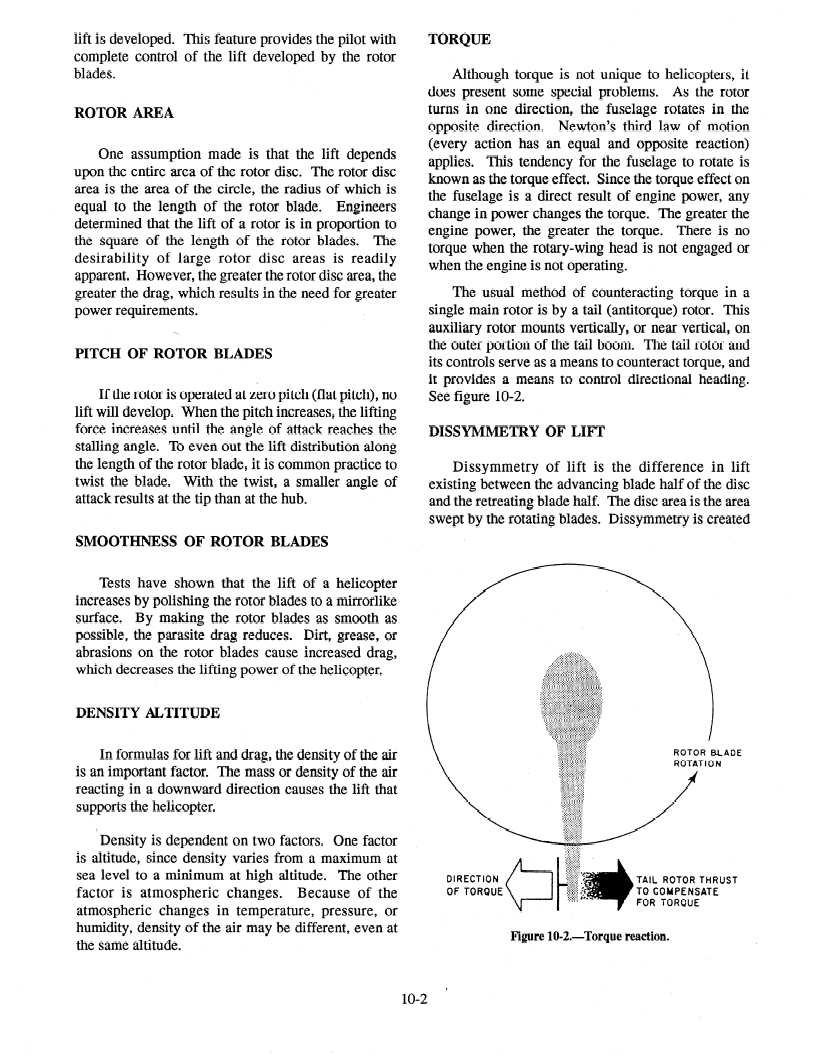lift is developed. This feature provides the pilot with
complete control of the lift developed by the rotor
blades.
ROTOR AREA
One assumption made is that the lift depends
upon the entire area of the rotor disc. The rotor disc
area is the area of the circle, the radius of which is
equal to the length of the rotor blade. Engineers
determined that the lift of a rotor is in proportion to
the square of the length of the rotor blades. The
desirability
of large rotor disc areas is readily
apparent. However, the greater the rotor disc area, the
greater the drag, which results in the need for greater
power requirements.
.-. /
PITCH OF ROTOR BLADES
If the rotor is operated at zero pitch (flat pitch), no
lift will develop. When the pitch increases, the lifting
force increases until the angle of attack reaches the
stalling angle. To even out the lift distribution along
the length of the rotor blade, it is common practice to
twist the blade. With the twist, a smaller angle of
attack results at the tip than at the hub.
SMOOTHNESS OF ROTOR BLADES
Tests have shown that the lift of a helicopter
increases by polishing the rotor blades to a mirrorlike
surface. By making the rotor blades as smooth as
possible, the parasite drag reduces. Dirt, grease, or
abrasions on the rotor blades cause increased drag,
which decreases the lifting power of the helicopter.
DENSITY ALTITUDE
In formulas for lift and drag, the density of the air
is an important factor. The mass or density of the air
reacting in a downward direction causes the lift that
supports the helicopter.
‘Density is dependent on two factors. One factor
is altitude, since density varies from a maximum at
sea level to a minimum at high altitude. The other
factor is atmospheric
changes.
Because of the
atmospheric changes in temperature, pressure, or
humidity, density of the air may be different, even at
the same altitude.
TORQUE
Although torque is not unique to helicopters, it
does present some special problems.
As the rotor
turns in one direction, the fuselage rotates in the
opposite direction.
Newton’s third law of motion
(every action has an equal and opposite reaction)
applies. This tendency for the fuselage to rotate is
known as the torque effect. Since the torque effect on
the fuselage is a direct result of engine power, any
change in power changes the torque. The greater the
engine power, the greater the torque.
There is no
torque when the rotary-wing head is not engaged or
when the engine is not operating.
The usual method of counteracting torque in a
single main rotor is by a tail (antitorque) rotor. This
auxiliary rotor mounts vertically, or near vertical, on
the outer portion of the tail boom. The tail rotor and
its controls serve as a means to counteract torque, and
it provides a means to control directional heading.
See figure 10-2.
DISSYMMETRY
OF LIFT
Dissymmetry
of lift is the difference in lift
existing between the advancing blade half of the disc
and the retreating blade half. The disc area is the area
swept by the rotating blades. Dissymmetry is created
. . . . . .
*.**..*:..,
*.*,......*,
.
*.*.*.*.*.*.
..*...m.*.*.
..:.:.:.:.:.
*.-**.'.*,-
S.'....
..,.
DiRECTiON
:.‘A’.‘.’
.
v.*.*.*.
.‘.‘.‘.‘.
OF TORQUE
ot
.
.
...‘.
:.>:.:.
TAIL ROTOR THRUST
-.*.*2..
‘A*,‘,
‘.‘A*,~
‘........
TO COMPENSATE
.:.:.:.:
FOR TORQUE
Figure lo-2.-Torque
reaction.
10-2

